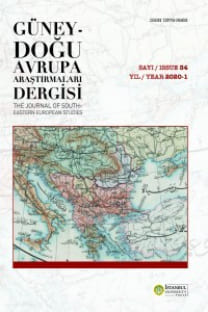ENDÜLÜSLÜ BIR MÜTERCIMIN GÖZÜYLE XVII. YÜZYILDA AVRUPA: AHMED B. KÂSIM EL-HACERÎ’NIN FRANSA VE HOLLANDA SEYAHATI
XVI. yüzyılın ikinci yarısında Endülüs’te doğan Ahmed b. Kâsım el-Hacerî, gençlik yıllarını Endülüs’te geçirdikten sonra Kuzey Afrika’ya göç etmiş ve Merakeş’te Sa‘dî sultanının mütercimi olarak saray hizmetine girmiştir. Merakeş’e gidişinden bir süre sonra, malları Fransız gemiciler tarafından gasp edilen bir grup Endülüslü Müslümanın bu olayı Sa‘dî sultanına arz etmesi üzerine, gasp edilen malların kurtarılarak sahiplerine iade edilmesi amacıyla Hacerî’nin riyasetinde bir heyet Fransız kralına gönderilmiştir. Bu yolculuk esnasında Hıristiyan ve Yahudi din adamlarıyla da görüşen Hacerî, kendisinden söz konusu seyahatleri esnasında görüp karşılaştıklarını yazması talep edilince, Rıhletü’ş-şihâb ilâ likâi’l-ahbâb adıyla bir eser telif etmiştir. Bugün Hacerî’nin seyahatnamesi niteliğinde elimizde bulunan Nâsırüddîn ale’l-kavmi’l-kâfirîn adlı eser, günümüze ulaşıp ulaşmadığı bilinmeyen Rıhletü’ş-şihâb’ın müellif tarafından Mısır’da kaleme alınan muhtasarıdır. Bu çalışma, Hacerî’nin seyahatnamesini Fransa ve Hollanda’da diğer din mensuplarıyla yaptığı teolojik tartışmalar merkezinde incelemeyi amaçlamaktadır.
Anahtar Kelimeler:
Ahmed b. Kâsım el-Hacerî, Endülüs, Mağrib, Fransa, Hollanda, oryantalizm, seyahatname
The Europe from the Eyes of an Andalusian Interpreter in the 17th Century: Ahmad b. Qāsim al-Hajarī’s Travel to France and to the Netherlands
Ahmad b. Qāsim al-Hajarī, who was born in al-Andalus at the second half of the 16th century, immigrated to North Africa after spending his early life in al-Andalus and came into service of the Sa‘di’s sultan in Marrakech as court interpreter. After he arrived to Marrakech, a group of Andalusian Muslims, whose properties were seized by French sailors, informed to the Sultan of Sa‘di regarding this event and a committee under Hajarī, were taken into service in order to recovery and give back to their properties, were sent to the French king. During this voyage, Hajarī met with Christian and Jewish religious men; after that, Hajarī wrote his memories in the travel book that was called Rihla al-shihāb ilā liqā al-ahbāb because this kind of book was demanded. Nāsir al-dīn alā al-qawm al-qāfirīn, which was written in Egypt as the brief of Rihla al-shihāb is his travel book, we do not have any information about it. At this regard, this article aims to investigate Hajarī’s travel book at the centre of his theological discussions with Christian and Jewish religious men in France and Holland.
Keywords:
Ahmad b. Qāsim al-Hajarī, al-Andalus, Maghreb, Frence, Holland, orientalism, travel book.,
___
- ADIGÜZEL, Cumhur Ersin, “Hacerî”, DİA, Ek Cilt I, 2016, 501-503.
- BÁEZ CABRERA, Mauricio Marcelino, “Historia de las Vivencias de Algunos de los Judíos Sefardíes Españoles en su Tránsito y su Posterior Asentamiento en Coro en el Siglo XIX”, Revista Mañongo, no. 35, sy. XVIII, Julio-Diciembre 2010, s. 115-137.
- BERNABÉ-PONS, Luis F., “Una nota sobre Ahmad ibn Qāsim al-Hayarī Bejarano”, Sharq al-Andalus, 13, 1996, s. 123-128.
- ____________________, “Por la lengua se conoce la nación: Los Moriscos y sus idiomas”, Alborayque, III, 2009, s. 107-125.
- __________________, “Taqiyya, niyya y el Islam de los moriscos”, al-Qantara XXXIV/2, 2013, s. 491-527.
- COHEN, Shai, “El retorno de los judiosconversos portugueses en época del conde duque de Olivares”, Hipogrifo, volumen exrtraordinario: 1, 2018, s.191-215.
- DE EPALZA, Míkel, Los Moriscos antes y después de la expulsión, Madrid 1992.
- ERDEM, Sargon, “Aljamiado”, DİA, II, 1989, s. 465-466.
- GARCÍA-ARENAL, Mercedes, “La Inquisición y los Libros de los Moriscos”, Memoria de los Moriscos: Escritos y Relatos de una Diáspora Cultural (koor. Alfredo Mateos Paramio), Madrid 2010, s. 57-71.
- GARCÍA-ARENAL, Mercedes; Fernando Rodriguez Mediano, The Orient in Spain: Converted Muslims, the Forged Lead Books of Granada, and the Rise of Orientalism, Leiden 2013.
- HACERÎ, Ahmed b. Kâsım, Kitâbu Nâsıruddîn ale’l-kavmi’l-kâfirîn (thk. P.S. Van Koningsveld, Q. Al-Samarrai, G.A. Wiegers), Madrid 2008.
- HARVEY, L. P., “The Morisco who was Muley Zaidan’s Spanish Interpreter”, Miscelánea Estudios Árabes y Hebraicos, VIII, 1959, s. 67-97.
- ___________, Muslims in Spain: 1500 to 1614, Chicago 2006.
- LÓPEZ BARALT, Luce, Islam in Spanish Literature: From the Middle Ages to the Present, Leiden 1992.
- MATAR, Nabil, In the Lands of the Christians: Arabic Travel Writing in the Seventeenth Century, New York 2003.
- ÖZDEMİR, Mehmet, “İspanya Krallığı’nın XVI. Yüzyılda Endülüs Müslümanlarını Hıristiyanlaştırma Politikası (I)”, Ankara Üniversitesi İlahiyat Fakültesi Dergisi, c. XXXV, 1996, s. 243-284.
- RAVILLARD, Martine, “Los moriscos en Berbería”, Nueva Revista de Filología Hispánica, XXX/2, 1981, s. 617-629.
- SOYER, François, “King João II of Portugal, O Principe Perfeito and the Jews (1481-1495), Sefarad 69/1, 2009, s. 75-99.
- ŞEŞEN, Ramazan, “İdrîsî, Şerîf”, DİA, XXI, 2000, s. 493-495.
- VALLVÉ BERMEJO, Joaquín, Al-Andalus: Sociedad e Instituciones, Madrid 1999.
- WIEGERS, Gerard, “Moriscos and Arabic Studies in Europe”, al-Qantara, XXXI/2, 2010, s. 587-610.
- ______________, “El contenido de los textos Árabes de los plombos: El Libro de los Misterios Enormes (Kitāb al-Asrār al-‘Azīma) como polémica Islámica anticristiana y antijudía”, Nuevas aportaciones al conocimiento y estudio del Sacro Monte: IV. centenario fundacional (1610-2010) (ed. M. J. García-Ferrer, M. L. García Valverde, A. López Carmona), Granada 2011, s. 199-214.
- ZENÓN, Jesús, “Los Estudios de Lengua Árabe entre los Moriscos Aragoneses a través de los Manuscritos de la Junta”, Sharq al-Andalus, XII, 1995, s. 363-374.
- ZOZAYA MONTES, Leonor, “A Thorn in the Community: Popular Religious Practice and Converso Dissidence in the District of Molina de Aragon”, The convertors and moriscos in late medieval Spain and beyond I: Departure and change (ed. Kevin Ingram), Leiden 2009, s. 161-186.
- ISSN: 0378-3863
- Başlangıç: 1974
- Yayıncı: İstanbul Üniversitesi
Sayıdaki Diğer Makaleler
OSMANLI DEVLETI’NDE ÖREN YERLERINI INCELEMEYE GELEN SEYYAHLAR
Verney Lovett Cameron, Türkler Arasında, çev. Sema Özgün, Istanbul: Dergâh Yay., 2018, 120 s.
Doğu Seyahatnamesi Bir Dominikan Keşişin Anadolu ve Ortadoğu Yolculuğu
Heinrich Barth Seyahatnamesi: Trabzon’dan Üsküdar’a Yolculuk
